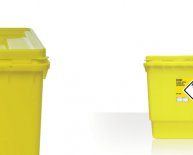
Dental Clinical Waste Disposal
There are a number of hazardous dental wastes that when disposed improperly, could cause harm to us and the environment. Most chemical waste streams generated in dental office can be managed as nonhazardous waste, if proper disposal guidelines are followed. These include:
Mercury-containing wastes
Dental Amalgam particles are a source of mercury which is known to be a neurotoxic, nephrotoxic, and bioaccumulative element. It can get into the environment through waste water, scrap amalgam or vapors. Vaporous mercury waste management includes: (1) storing unused elemental mercury in a tightly sealed container, (2) contacting a certified biomedical waste carrier (CWC) for recycling or disposal, (3) using a “mercury spill kit” in case of a spill of mercury, (4) reacting unused elemental mercury with silver alloy to form scrap amalgam, (5) not placing elemental mercury in the garbage, and (6) not washing elemental mercury down the drain. Scrap amalgam waste management entails (1) using disposable suction traps and amalgam separators on dental suction units, the traps should be changed weekly to prevent amalgam accumulation, (2) mixing only required amalgam amount or using premeasured amalgam capsules, (3) Not throwing extracted teeth with amalgam fillings in the regular garbage, (4) using a mercury container to store all scrap/old amalgam, which is passed on to the CWC.(, )
Silver-containing wastes
(A) Spent X-ray fixer used in dental clinics to develop X-rays is a hazardous material that should not be simply rinsed down the drain. After desilvering the fixer with a recovery unit, it can be mixed with developer and water and disposed down the sewer or septic system. Spent developer is permitted to be discharged in the above systems after dilution with water. The silver should be handed over to the CWC. Using a digital X-ray unit and an X-ray cleaner without chromium are other suggested safety measures. (B) Undeveloped X-ray films contain a high level of silver and must be treated as hazardous waste. It is advisable to collect any unused film that needs disposing in a recommended container for recycling by the disposal company. Using a digital X-ray unit minimizes purchase of new X-ray films.(, )
Lead-containing wastes
The lead foil inside X-ray packets and lead aprons contain leachable toxin which can contaminate soil and groundwater in landfill sites after disposal. These should only be handed over to CWC. High doses of lead intake lead to reproductive toxicity, neurotoxicity, carcinogenicity, hypertension, renal function, immunology, toxicokinetics, etc.
Blood-soaked/dripping gauze
Is a biomedical hazardous waste. It should be enclosed in a yellow biomedical waste bag covered with a double bag, labeled with a biohazard symbol and refrigerated, if onsite for more than 4 days. Once accumulated, a CWC should be contacted for disposal.
Sharps
(Needles, scalpels, glass carpules, burs, acid etch tips, files, blades and other sharp objects): Their waste management includes collection in a red or yellow puncture resistant container with a lid that cannot be removed. The container should be properly labeled with biohazard symbol and once full, the CWC should be contacted for disposal.
Chemicals, disinfectants, and sterilizing agents
Staff handling these materials should be trained in Workplace Hazardous Materials Information System (WHMIS). Whenever possible, use steam or dry heat to sterilize dental instruments. Nonchlorinated plastic containers (not PVC) should be preferred to minimize environmental impacts and placed in the solid waste stream. Halogenated sterilants have a detrimental effect on environment. Ignitable sterilants should not be poured down the drain as they have potency to explode. HCHO sterilants should also not be disposed down a drain. One should not pour sterilants into a septic system as this may significantly disrupt the bacteria which normally breakdown wastes.(, )
Nonhazardous wastes
(Paper, cardboard, aluminum, plastics, etc.): Their use should be minimized. Containers or packaging made of PVC plastic should be avoided where feasible, as this is difficult to recycle and can produce acid gases if incinerated. Paper waste, cardboard, and plastic containers (clean or rinsed) should be recycled where the service exists.
We wish to emphasize that in addition to health risks, improper waste management also has an impact on the environment causing pollution of water, air, and soil. The need of the day is to sensitize the dentists to the various types of waste, their generation, segregation, collection, transportation, and final disposal.
















